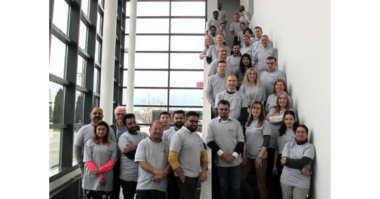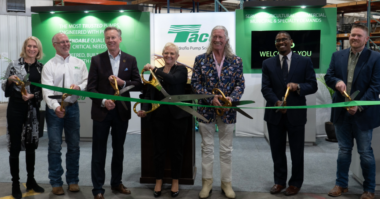Thomas Fuller once said, “We never know the worth of water until the well is dry.”
This has become painfully clear to the citizens of California and to other arid regions throughout the world.
Water essential to everything we do.
Without water, we cannot grow food. Seventy percent of the world’s water supply is used for agriculture and irrigation. Without water, we have no proper sanitation or proper hygiene. Eighty percent of the world’s wastewater is not collected or treated.
Without water, we have no power to generate electricity. It requires 16 gallons of water to operate a 60-watt light bulb for 12 hours.
Water is used in oil & gas operations. For every barrel of oil we pull out of the ground, we use 10 barrels of water. A single oil well can require up to 5 million gallons of water.
Yes, water is absolutely essential to our lives.
But there are still more than 750 million people worldwide who have no access to clean water. Women and children spend about 140 million hours each day collecting water. The task is so daunting and time intensive that the women do not have time to work. The children do not have time to go to school or to play. And the water they collect is filthy.
About 3.5 million people die each year as a result of inadequate water supply, poor sanitation and hygiene and water borne diseases.
In many parts of the world, including the United States, we take our abundant access to clean water for granted. We take long showers and let the water flow from the taps while we casually brush our teeth. We water our lawns and wash our cars and rarely give a second thought to the cost of clean water.
Population growth, climate change and natural and manmade disasters require a need for better, smarter and more sustainable technologies. And the availability of water and energy could determine the future of life itself.
We all track the cost of a gallon of oil daily. But we rarely stop to consider the cost of water. And even the bigger question, will there be enough?
There is good news.
Government regulators, industry leaders and citizens of the world are beginning to think differently about water. We are beginning to work together to create sustainable solutions. And we are thinking about water and energy collectively as the understanding of the natural nexus between water and energy becomes more clear to us all.
In many areas where oil is the most abundant, water is the most scarce. And until we have a more clear focus on the value of water – whether that be sources of clean water, the climate of the energy cycle or the management of wastewater – our current condition is simply not going to be sustainable.
The Department of Energy has gotten involved. Last year it released a 250-page report about the opportunities and challenges of the water-energy nexus. The World Health Organization is also paying attention. It predicts that by 2020 two thirds of the nearly 10 billion people on earth will live in developed cities, creating tremendous pressure on global energy and water resources.
In arid regions like the Middle East people use three times the global average of water daily, and population is increasing at a rapid pace. The UAE government is considering taking a lead from governments such as in Australia, where extreme climate change generated action in the way people in that region think about water. In Perth, each person’s daily use of water is now regulated. This water budget is mandated by the government and strictly enforced. And it’s working.
According to Adam Lovell, executive director of the Water Services Association of Australia, citizens of Perth no longer say “We need to conserve water.” Now they say “We need to use every drop wisely.”
And the rest of that continent is following this example.
In pumping applications, efficiency and sustainability is at the heart of these challenges because pumps demand so much energy consumption. Pumps account for 20 percent of the global energy demand. Energy efficient pumping systems reduce the impact on both energy and water consumption.
Water is needed for energy and energy is needed for water. While the connection is clear, there is an obvious disparity in how water and energy are priced, regulated and managed. Water is regulated locally, but water is a global issue.
Some of the key solutions lie in water reuse opportunities. Oil operators are finding creative ways to reuse water sources. For example, Shell partnered with the Global Municipal Water Authority to build a wastewater treatment facility in Canada where the water offtake from the treatment plant is now used in Shell oil operations.
Technologies are being developed to decrease water heat in power plants through combined power and desalination plants. And using solar energy for power and water treatment is being used more as huge facilities are being built worldwide, including in Khafji, Saudi Arabia where the biggest solar-powered desalination facility is currently being built.
Systems are being improved with sensors, data collection, analysis and reporting.
Nontraditional water sources are being considered, for example using non-freshwater sources such as brackish water, seawater or wastewater for cooling purposes. And there is a focus on plant integrations that include water reuse and renewable energy systems.
Some world leaders and government regulators are defining strategic approaches that include financial and economic incentives for corporations that promote sustainability and creative water reuse. By working with regulators on a case-by-case basis, we can continue to work together on ways to take water to the next reuse.
As the residents of California and other arid regions are becoming increasingly aware, water is arguably our most precious resource. In fact, not many people would even argue with that. Water is our most precious resource.
If we can continue to work together to find more sustainable ways to treat water, transport water and reuse water, we can protect this precious resource that is so vital to our lives every single day.
Carl Sagan once said, “Anything else you’re interested in is not going to happen if you can’t breathe the air and drink the water. Don’t sit this one out. Do something. You are by accident of fate alive at an absolutely critical moment in the history of our planet.”
The last thing Sir Peter Blake wrote was this…“The quality of water and the quality of life in all its infinite forms are critical parts of the overall, ongoing health of this planet of ours… The hardest part of any big project is to begin. We have begun. We are underway. We have a passion. We want to make a difference.”
Industry leaders are working to make a difference. In May of 2015, the first ever Water Technology & Funding Summit brought together regulators and legislators to work on possible solutions. There were several other industry events in 2015 that focused on clean water solutions, including the International Desalination World Congress (held in the U.S. for the first time in 16 years) and the American Water Summit.
This will continue to be a hot topic for the pump industry in 2016. AWWA, WQA Aquatech, IFAT, WEFTEC and other events will continue to discuss ways to solve the world’s water challenges.




Comments